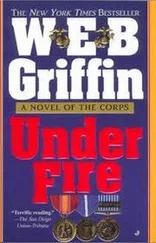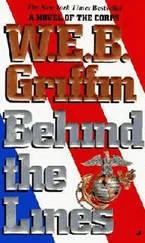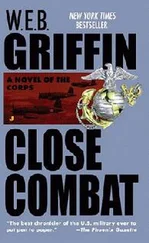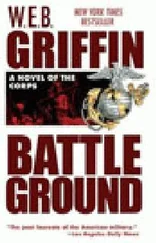W.E.B. Griffin - The Corps V - Line of Fire
Здесь есть возможность читать онлайн «W.E.B. Griffin - The Corps V - Line of Fire» весь текст электронной книги совершенно бесплатно (целиком полную версию без сокращений). В некоторых случаях можно слушать аудио, скачать через торрент в формате fb2 и присутствует краткое содержание. Жанр: prose_military, на английском языке. Описание произведения, (предисловие) а так же отзывы посетителей доступны на портале библиотеки ЛибКат.
- Название:The Corps V - Line of Fire
- Автор:
- Жанр:
- Год:неизвестен
- ISBN:нет данных
- Рейтинг книги:4 / 5. Голосов: 1
-
Избранное:Добавить в избранное
- Отзывы:
-
Ваша оценка:
- 80
- 1
- 2
- 3
- 4
- 5
The Corps V - Line of Fire: краткое содержание, описание и аннотация
Предлагаем к чтению аннотацию, описание, краткое содержание или предисловие (зависит от того, что написал сам автор книги «The Corps V - Line of Fire»). Если вы не нашли необходимую информацию о книге — напишите в комментариях, мы постараемся отыскать её.
The Corps V - Line of Fire — читать онлайн бесплатно полную книгу (весь текст) целиком
Ниже представлен текст книги, разбитый по страницам. Система сохранения места последней прочитанной страницы, позволяет с удобством читать онлайн бесплатно книгу «The Corps V - Line of Fire», без необходимости каждый раз заново искать на чём Вы остановились. Поставьте закладку, и сможете в любой момент перейти на страницу, на которой закончили чтение.
Интервал:
Закладка:
General Kawaguchi's orders from General Hyakutake were to retake the airstrip (Henderson Field) as a first priority. Once that was accomplished, the Americans could no longer send aircraft aloft to intercept Japanese aviation and Naval forces.
Then throwing them back into the sea would be a relatively easy matter.
On 12 September, of course, Edson had no way of knowing about any of this. His only information was what he'd suspected-which Griffith now confirmed-that he was about to get involved in a battle with several thousand fresh and probably well-led Japanese troops.
He did what experience had taught him. He ordered several strong patrols to set out at first light to gather more information about the enemy; and he summoned an officer's call to explain the situation to his command.
Edson's situation map showed the disposition of his forces along a T-shaped ridge about a mile south of the Henderson Field runway. The cross of the T was clear, broken ground with four spurs, two on each side of the ridge that formed the 1000-yard-long base.
Baker and Charley companies of the Raiders were on the line. Able and Dog companies were in reserve, close to the line.
Raider headquarters and elements of Easy Company (Heavy Weapons) were several hundred yards back from the front, on the base of the T.
Remnants of the badly hurt Parachute Battalion were mixed in with the Raiders. Baker Company, Parachutists, down to seventy men, was next to Baker Company, Raiders. The parachutists of Able and Charley companies were in the wooded area near the bottom of the base of the T. And what was left of the Parachute Battalion command post was near Edson's CP.
It was generally agreed that the Japanese would probably attack toward Henderson Field from their positions south of the ridge down the long axis of the base of the T.
Marine fields of fire were discussed. It was finally concluded that given the limited resources, all that could be done had been done. They would just have to wait until morning and see what happened.
At about 2100, just as Colonel Edson was about to dismiss his officers, the Japanese attacked. Japanese artillery located east of Alligator Creek opened fire. A moment later a parachute flare burst in light over the south end of Henderson Field.
Moments after that, Japanese Naval gunfire began to land on the ridge.
By morning, what had been somewhat impersonally identified as "the ridge" would be forever known as "Bloody Ridge."
Chapter Nine
[One]
HEADQUARTERS,
1ST RAIDER BATTALION
GUADALCANAL, SOLOMON ISLANDS
0445 HOURS 13 SEPTEMBER 1942
Lieutenant Colonel Merritt "Red Mike" Edson was staring closely at a map of Guadalcanal that covered the small, folding wooden table where he'd spread it. The Japanese had attacked hard last night, and he was trying to make some sense of their movements.
When Colonel Edson glanced up from the map, another Marine was standing beside the table looking down at the map with great interest. He had not been there three minutes before and he was not a member of the 1st USMC Raider Battalion I'm annoyed for some reason, Edson thought. I wonder why?
"Good morning, Jack," Edson said. "I didn't see you come in.
"Good morning, Sir," the Marine said crisply, almost coming to attention.
He would have come to attention, Edson thought, if he wasn't cradling that Mickey Mouse rifle of his in his arms like a deer hunter.
Major Jack (NMI) Stecker, USMCR, Commanding Officer, 2nd Battalion, Fifth Marines, was one of the very few people on Guadalcanal armed with the U.S. Rifle, Caliber.30-06, MI, known after its inventor as the Garand.
Most of The Marine Corps (including Lieutenant Colonel Edson) believed that compared to the U.S. Rifle, Springfield, Caliber.30-06, Model 1903, the Garand was a piece of shit.
Major Jack (NMI) Stecker was sure these people were wrong. Not only could the eight-shot, semiautomatic Garand be fired far more rapidly than the five-shot, bolt-operated Springfield, but it was also his professional judgment that the Garand was every bit as reliable as the Springfield (minor Marine Corps heresy) and more accurate (major Marine Corps heresy).
Before the war, when he was Master Gunnery Sergeant Stecker, he represented The Corps at the testing of the new rifle at Fort Benning, Georgia. After that, he regularly and frequently augmented his income by putting his money where his mouth was when other senior staff noncommissioned officers questioned the accuracy of the Garand.
On 7 December 1941, Stecker was the senior noncommissioned officer at Quantico. Shortly afterward he was called to active duty as a captain, and a short time after that, he was promoted to major.
Though it was rarely put into words, professional Marine officers often felt a certain ambivalence about Mustang officers.
On the one hand, obviously, The Corps needed more officers than were available; and just as obviously it made more sense to put officers' insignia on veteran senior noncommissioned officers than to commission men directly from civilian life.
On the other hand, there was no substitute for experience. In the case of Major Jack (NMI) Stecker, for instance, his first command was his present command, 2nd Battalion, Fifth Marines. Previous to that assignment he had never commanded a platoon or served as a company executive officer, company commander, battalion staff officer, or battalion executive officer.
I n the minds of many officers, including many who honestly regarded him as one of the best master gunnery sergeants in the Marine Corps, Jack (NMI) Stecker had not actually earned either his promotion to major or his command of 2nd Battalion, Fifth Marines. As they saw it, he got his promotion and his command (over a dozen or so regular officers) largely because he was a lifelong friend of Brigadier General Lewis T. "Lucky Lew" Harris, now assistant First Marine Division commander.
Harris first met Stecker in World War I. Second Lieutenant Lewis T. Harris had been Corporal Jack (NMI) Stecker's platoon leader during an engagement that caused Corporal Stecker to stand out from other Marines, officer or enlisted. In recognition of the conspicuous part he played in that engagement, he was awarded his nation's highest award for valor and gallantry. He was rarely seen wearing it, but he was entitled to top his rows of medals and campaign ribbons with a blue ribbon dotted with white stars which signified that the President of the United States, on behalf of the U.S. Congress, had awarded him the Medal of Honor.
Second Lieutenant Harris was one of the two dozen Marines whose lives," in the words of the award citation, "had been saved by Corporal Stecker's utter disregard of his own personal safety and painful wounds while manifesting extraordinary courage above and beyond the call of duty in the face of apparently overwhelming enemy force, such actions reflecting great credit upon himself, the U.S. Marine Corps, and the Naval Service of the United States."
"I don't suppose you're here, Jack," Edson said to Stecker, "to tell me we're being relieved by Second of the Fifth?" It was a remark made in jest. But Stecker did not take it that way.
"No, Sir. But I wouldn't be surprised if we were sent up here to reinforce. I thought I should make the time to come up and look around." Yes, Edson thought, of course you did. You may be Lew Harris' life long friend, and you do have The Medal, but that's not why they gave you the 2nd of the Fifth. They gave it to you because you are one hell of a good Marine officer, which you proved beyond any question on Tulagi, and again just now, by anticipating the orders you'll probably receive, an preparing yourself and your battalion for them.
"Would you like me to... ?" Edson asked, gesturing at the map.
"I'd be grateful, Sir, if you could spare the time."
Читать дальшеИнтервал:
Закладка:
Похожие книги на «The Corps V - Line of Fire»
Представляем Вашему вниманию похожие книги на «The Corps V - Line of Fire» списком для выбора. Мы отобрали схожую по названию и смыслу литературу в надежде предоставить читателям больше вариантов отыскать новые, интересные, ещё непрочитанные произведения.
Обсуждение, отзывы о книге «The Corps V - Line of Fire» и просто собственные мнения читателей. Оставьте ваши комментарии, напишите, что Вы думаете о произведении, его смысле или главных героях. Укажите что конкретно понравилось, а что нет, и почему Вы так считаете.









